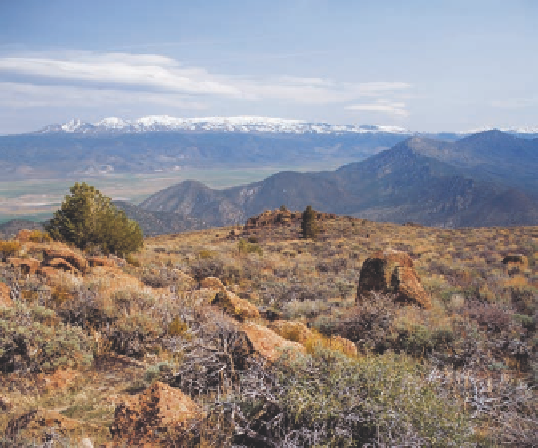Geoscience Reference
In-Depth Information
to latitude, with lower-latitude locations usually being arid to
semi-arid and those at higher latitudes more humid. (
Why do you
think this pattern occurs?
) Regardless of the amount of rainfall re-
ceived, the temperature in these regions is usually moderate with
a very mild seasonal variation that may range from about 13°C
(55°F) in January to 28°C (83°F) in August. The vegetation in
this region is characterized by shrubs and trees that have thick,
hard leaves (Figure 9.8) designed to retain moisture during long
summer droughts.
The third type of mesothermal climates are the marine west-
coast climates (
Cfb
,
Cfc
), which are found dominantly on the west
coast of continents between 35° to 60° N and S latitude (see Figure
9.2). In North America this climate occurs from Oregon to north-
ern British Columbia and also occurs on the east side of the con-
tinent in the Appalachian Mountains. Elsewhere, this climate is
found in the British Isles, the west coast of Europe, New Zealand,
the southern tip of Australia, and southern Chile. The distinction
between the
Cfb
and
Cfc
subcategories is that the
Cfb
zones have
four months with temperatures
>
10°C (50.0°F), whereas
Cfc
cli-
mate zones have fewer than four months that warm.
Given the higher latitude of these locations, they are more
directly, and more frequently, in the path of the westerly storm
track that brings cool, moist mP air masses from the large oceans
to the west. Therefore, marine west-coast locations receive more
precipitation than Mediterranean regions. This precipitation is
magnified by orographic processes when mP air masses encoun-
ter large mountain ranges, such as the Cascades in the north-
west United States or the Andes in Chile. In regions where this
geographical interplay occurs, the amount of annual rainfall is
prodigious, exceeding 254 cm/year (100 in./year). As you might
expect, marine west-coast regions have a greater annual tempera-
ture range than their Mediterranean counterparts at lower lati-
tudes, but the winters are still very mild compared to continental
locations. Due to this heavy precipitation, the native vegetation
in these areas consists of dense needle-leaf forests (Figure 9.9).
Figure 9.7 The humid subtropical hot-summer climate (
Cfa,
Cwa
).
Along the Gulf Coast of the United States, the vegetation
in many places is the kind of broadleaf evergreen forest shown here.
Figure 9.9 The marine west-coast climates (
Cfb, Cfc
).
Nee-
dle-leaf forest in the Hoh Rainforest at Olympic National Park,
Washington. Here, abundant precipitation associated with the
marine west-coast climate (
Cfb
,
Cfc
) supports a dense forest of
Sitka spruce, hemlock, and various ferns and mosses.
Figure 9.8 The Mediterranean dry-summer climates (
Csa,
Csb
).
The California chaparral is associated with the
Cs
climate
and consists of wiry shrubs that retain moisture during summer
dry periods.





